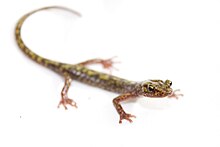Green salamander
| Green salamander | |
|---|---|
 |
|
| Scientific classification | |
| Kingdom: | Animalia |
| Phylum: | Chordata |
| Subphylum: | Vertebrata |
| Class: | Amphibia |
| Order: | Caudata |
| Family: | Plethodontidae |
| Genus: | Aneides |
| Species: | A. aeneus |
| Binomial name | |
|
Aneides aeneus (Cope & Packard, 1881) |
|
| Synonyms | |
|
|
The green salamander (Aneides aeneus) is a member of the lungless salamanders, family Plethodontidae. It is the only member of the Aneides genus that inhabits the Eastern United States (all other Aneides salamanders are found in the west). Rarely seen in the field, the green salamander is an extremely habitat-specific species that is seldom found away from its preferred surroundings: moist, shaded rock crevices.
The green salamander is small and notably flat. Aneides aeneus‘ green, lichen-like blotches against a darker dorsum make it the only salamander in North America with green markings.A. aeneus possesses squared toe-tips, large, conspicuous eyes, and a light blue to yellow ventral surface. Adults range from 8–12 cm (3 to 5 in) with 14 to 15 costal grooves.
Currently, aeneus is the only species of the Aneides genus found in the Eastern United States. Some claim that there may be up to four different species of Aneides between the Cumberland Plateau and Blue Ridge Escarpment populations, but there has yet to be published molecular data to prove or disbar these claims.
Aneides aneus is the only salamander in North America with green markings. Due also to A. aneus ’ hyper-specific habitat, it is almost unmistakable when found in the field.
Aneides aeneus is known to inhabit both the Alleghenies and Cumberland Plateau, reaching from southwestern Pennsylvania to northern Alabama and northeastern Mississippi. It is also commonly found in South-Central Ohio. Isolated populations are known at the Blue Ridge Escarpment at the junction of Georgia, North Carolina and South Carolina. The range of the Alleghenies and Cumberland Plateau extends southwest from Fayette County, Pennsylvania through eastern West Virginia, eastern Kentucky, the extreme western portions of Virginia, Tennessee, and Alabama. The population discovered in 1930 in the Great Smoky Mountains National Park has not been located since. However a population is known in the Sampson Mountain Wilderness Area, presumably unknown until 2012 (Gunnin et al. 2012). There may be disjunct populations on Clinch Mountain, on Bays Mountain and the Appalachian Ridge and Valley, and in the Inner Central Basin of Tennessee (Redmond and Scott, 1996). Tristan Clark has confirmed several distinct populations of green salamanders on Bays Mountain and one unusually large population from a remote area of the mountain. (Clark, 2015)
...
Wikipedia

